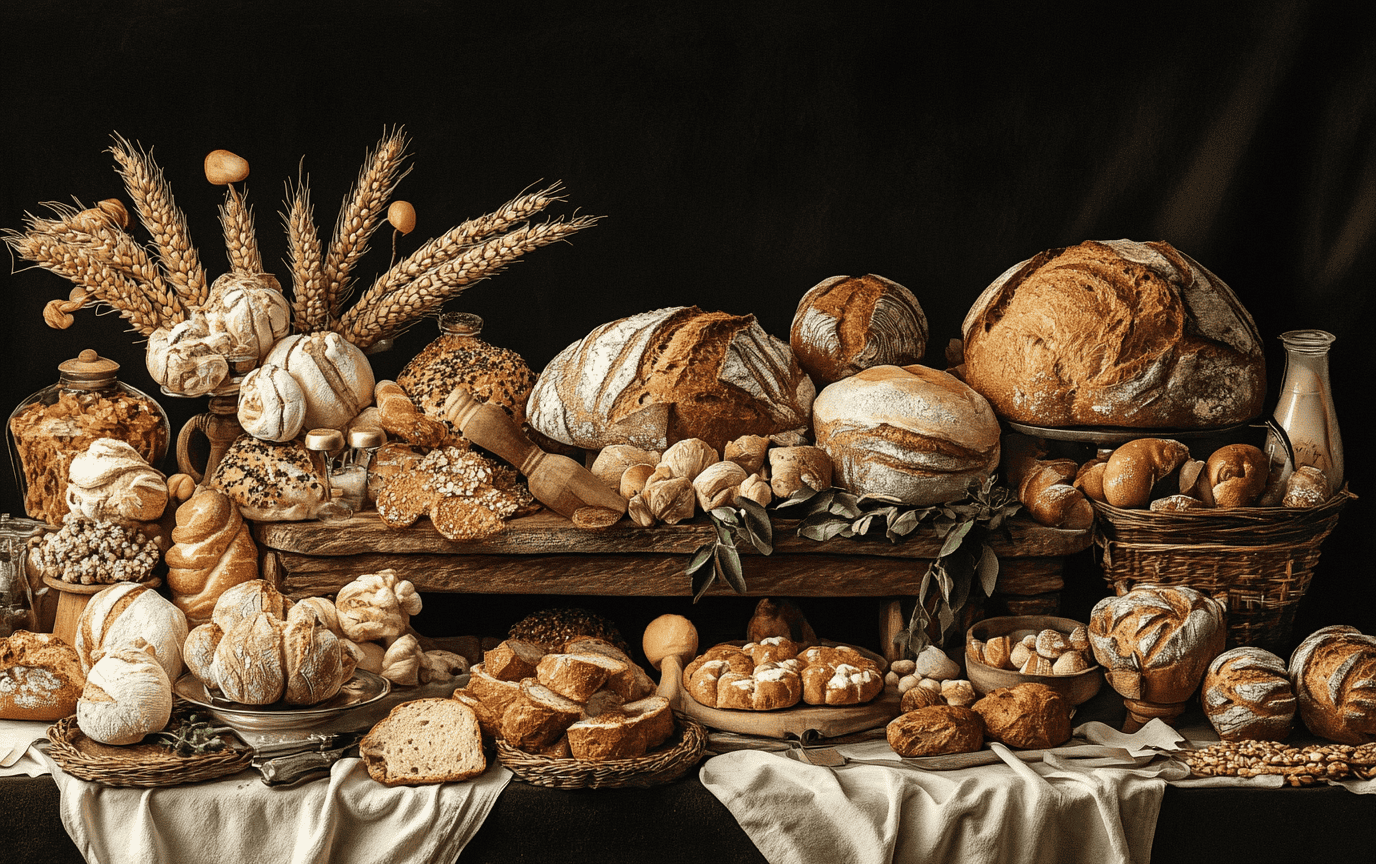The Art of Bread Making: A Journey Through Global Baking Traditions
Bread. It whispers stories of ancient civilizations and nourishing gatherings around family tables. It cradles the essence of cultures, bridging the gap between generations. We break bread not just to feed ourselves, but to forge connections. Imagine the aroma wafting from a rustic oven, the crust crackling as it cools—there's magic in the art of bread-making that transcends time and space. Let’s embark on a journey to immerse ourselves in the vibrant tapestry of baking traditions worldwide and discover the secrets behind our cherished staple: bread.
A Brief History of Bread
The rich history of bread stretches back thousands of years. The earliest evidence of bread-making reveals charred crumbs found in the Black Desert of Jordan, dating between 14,600 and 11,600 years ago. These crumbs, crafted by Natufian hunter-gatherers, signify the beginning of humanity’s love affair with bread—a love deeply rooted in sustenance and community.
In ancient Egypt, flatbreads crafted from barley and emmer wheat emerged as culinary foundations. These early loaves were not only food but vessels—containers for meals, symbolizing the flourishing agricultural activities of the time. Picture a bustling ancient marketplace, merchants proudly displaying their warm, crusty loaves, as villagers gather to share in the day's harvest. Bread became essential, a binding thread in the fabric of society—a tradition that continues today.
European Traditions
Across the rolling fields of Europe, the impact of leavening agents revolutionized bread-making. The ancient Greeks paved the way with the invention of free-standing ovens, thus elevating baking from a domestic chore to a cherished art form. Their techniques were advanced; breads became an expression of creativity and skill.
The Romans further transformed baking into a respected profession, introducing the concept of bakery shops in bustling city centers. Today’s European breads reflect this rich history. From France’s crusty baguettes to the hearty, dense rye breads of Northern Europe, each loaf tells a story. Imagine the scene: a small boulangerie in Paris, the smell of warm baguettes enticing passersby. The baker, a true artisan, works deftly, dusting flour into the air like snowflakes, with the rhythmic kneading echoing a timeless ritual.
And then there’s Italy, where the simple and exquisite ciabatta or the soft, airy focaccia invites longing glances from all who cross their paths. A slice, a tear, a sharing of a moment—this connection through bread is universal.
Middle Eastern and African Traditions
Journeying into the heart of the Middle East, the cultural significance of bread becomes vividly clear. Traditional flatbreads like pita offer a puffed pocket of possibility, cradling meals and holding together flavors with grace. Just think of the first bite, the warm dough yielding to spices—it's a taste of heritage.
In contrast, Ethiopia shares its own culinary treasure with injera, a sour flatbread, large enough to serve as both a dish and a utensil. It embodies the shared experience of breaking bread together, leaving marks on the tablecloth of communal dining. In Morocco, khobz graces tables, often prepared in communal ovens, each loaf representing unity in a country steeped in tradition. Picture it: families congregating, hands reaching for the same warm loaf, laughter melding with the tantalizing scent of spices.
Asian Traditions
Traveling east to India, we discover the joyful diversity of bread forms: crispy papadum, fluffy naan—each bite has the ability to take you on a flavorful journey. Naan is traditionally cooked in a tandoor oven, imparting a smoky essence that resonates with diners both at street stalls and elegant feasts alike. Can you hear the sizzling? The anticipation as warmth envelops your hands while tearing a piece off the fresh naan, ready to scoop up any rich curry? It’s sheer delight.
Then there’s chapati, a simple flatbread ubiquitous across the subcontinent. In countless homes, it’s a daily staple that brings families together. Picture the rolling pin dancing over dough, a gentle rhythm echoing through kitchens, and children playing nearby, waiting for that first warm piece to accompany their meal.
Latin American Traditions
Heading further south, Latin America basks in a rich corn-based bread tradition. Arepas and tortillas reign supreme, essential staples that shape local cuisine. Imagine a bustling Mexican kitchen, the nixtamalized corn ground into masa harina, the dough pressed into thin circles and cooked until they puff imperceptibly on a hot comal. Tortillas are no mere bread; they are the canvases for tacos, enchiladas, and countless other culinary masterpieces. The joy lies not just in the taste but in the shared ritual of making and enjoying these beloved breads.
The Science of Bread Making
Yet beneath this romantic portrayal lies an intricate science. The chemistry of bread-making melds art with formulas. Mixing flour, water, yeast, and salt initially seems simple, but the transformative alchemy that occurs through fermentation and proofing is profound. The Maillard reaction, responsible for that irresistible golden crust, is a delicate interplay of heat and moisture, unlocking deep flavors that dance on taste buds. As the dough rises, it swells with promise—imagine that moment when you catch the scent of yeast mingling softly in the air, a nostalgic reminder of family kitchens lit with warmth.
Techniques such as scoring the loaf or utilizing a Dutch oven add another layer to this sensory experience. The crackling sound as bread emerges echoes the anticipation built up in a hot kitchen, a silence broken only by the knife meeting crust.
Modern Baking and Technology
Technology has undeniably transformed the baking industry, rendering this ancient craft more accessible. Digital ovens fine-tune the baking process, while pre-packaged yeast eliminates the guesswork for novice bakers. Yet despite these advancements, traditional recipes remain integral, serving as cultural anchors that connect us to our roots. Think of your grandmother’s notes in the margins of a weather-beaten cookbook—each smudge, a testament to a family history woven in flour and water.
Much akin to how a family recipe can transcend generations, the act of bread-making holds a mirror to our evolving society. Each loaf reflects influences of modern life while cherishing the past.
Guide to Making Bread at Home
For travelers yearning to explore the world of bread-making, embarking on a homemade journey is not just about producing a loaf. It’s about creating memories as rich and layered as the dough itself. Here’s how to get started on your bread adventure:
1. Gather Ingredients: Flour, yeast, salt, and water are basic building blocks. Feel free to infuse your bread with flavor—perhaps a dab of butter or a drizzle of honey to sweeten the process. This is your canvas.
2. Mix and Knead: Combine the dry ingredients, then introduce the water, mixing until a shaggy dough forms. Knead that dough with patience, embracing the tactile texture until it transforms into a smooth, elastic mass. Here, the magic begins beneath your very fingertips.
3. Let Rise: Cover your dough with a warm cloth, placing it in a draft-free area to rise. Keep an eye on it—watching it double in size is a testament to the power of yeast, a process steeped in anticipation.
4. Shape and Bake: Shape the dough into a loaf, brushing it with water for an extra crispy crust if desired. Slide it into a preheated oven, and let the inviting aroma fill your home like a warm hug.
Conclusion
The art of bread-making is one of beauty and tradition, a thread woven through diverse cultures and generations. Whether you’re a seasoned baker or a novice willing to embrace flour and explore baking traditions, pursuing the craft enriches your culinary journey. The bread you create tells a story—a narrative of heritage, a canvas of culture, and a bridge between people.
An exploration of global baking traditions opens our eyes to the ways we connect as a community, and the simple act of making bread feeds our souls as much as it fills our stomachs. So step into that kitchen, flour dusting your apron, and let the journey of bread unfold—each loaf is an adventure waiting to begin.
Interested in more insightful reads? Check out our Travel Tips section for the latest advice. For lifestyle inspiration, explore our Lifestyle category, and dive into amazing destinations at Destinations. Don't forget to connect with us on YouTube, or follow our adventures on Instagram and Pinterest.













